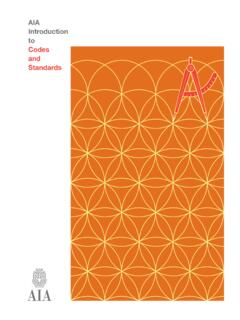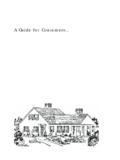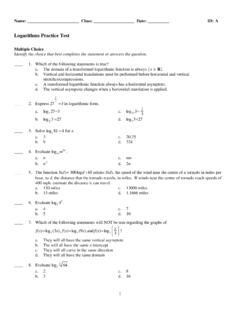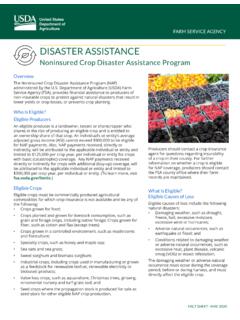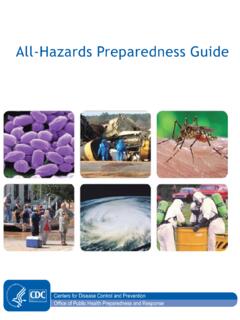Transcription of EMERGENCY PREPAREDNESS QUIZ ANSWERS - Hamilton …
1 EMERGENCY PREPAREDNESS quiz ANSWERS . 1. A family EMERGENCY plan is the best way to prepare you and your loved ones for a natural disaster or terrorist act. a. True: Be informed and prepared. Talk to your family about why you need to be prepared for disasters. Then, make a family EMERGENCY plan and practice it with your family. b. False 2. A family EMERGENCY plan consists of having EMERGENCY supplies and a first aid kit handy. a. True b. False: Storing EMERGENCY supplies is just one part of a plan. Your family members should know where the EMERGENCY supplies are stored, plus they should know: the news stations that will broadcast EMERGENCY information; escape routes from your house; your family's EMERGENCY contact numbers; where family members will meet if you get separated during an EMERGENCY ;. your child's school EMERGENCY plan; and your community's public alert system. 3. Every family member should be familiar with your EMERGENCY plan since they each play an important role.
2 A. True: From the youngest to the oldest, all family members can help, from gathering supplies to practicing how they would get out of the house in a hurry. b. False 4. How often should you practice your family EMERGENCY plan? a. Once a year b. Every six months c. Every three months: Your EMERGENCY plan should be practiced at least four times a year to make everyone familiar with it. d. Only during an EMERGENCY 5. A family EMERGENCY plan should NOT include which of the following? a. Information about the EMERGENCY plan at your children's schools b. The name and phone number of an out-of-town contact person c. A list of important phone numbers, including those of doctors and EMERGENCY services d. Arrangements for each person in the family to be at a specific land line telephone at a specific time: The arrangements for each family member to be at a specific land line telephone at a specific time may not be possible or useful during disasters.
3 Families should create an EMERGENCY plan and carry important information with them so they know how to get in touch and get back together during an EMERGENCY . Finally, both telephone land lines and cell phones may be overloaded or out of service during or after an EMERGENCY , so knowing in advance where to meet is important. e. A central meeting spot outside your home and one outside your neighborhood in case you need to leave the area 6. Which of the following is NOT a recommended action for EMERGENCY PREPAREDNESS ? a. Creating a family EMERGENCY plan b. Stockpiling antibiotics: Stockpiling antibiotics is not recommended because it is impossible to predict the exact nature of a biological EMERGENCY and there is not one antibiotic that effectively treats all possible bioterrorist-related sicknesses. In addition, inappropriate use of antibiotics can potentially lead to dangerous side effects and also contributes to the problem of many organisms developing antibiotic resistance.
4 C. Becoming knowledgeable about types of potential emergencies and responses d. Getting an EMERGENCY supplies kit 7. Since terrorism is unlikely in my community, preparing for emergencies is not as important for me as it is for some other people. a. True b. False: Emergencies can happen anywhere, and to anyone. You could lose electricity for a long time because of a severe storm, or be forced to leave your home due to a natural disaster. Plan to be prepared and you will be better able to help protect yourself and your family, no matter what happens! 8. It's a good idea to identify a centrally located room in your house or space in your basement, in case you and your family need to shelter in place.. a. True: During some kinds of emergencies you may be advised to stay at home and shelter in place, rather than evacuate. Look for space in your home that has no windows. b. False 9. You need to have a plan for your pets during emergencies.
5 A. True: Most shelters will not accept pets. Plan ahead of time what you will do with your pets if you have to leave your home unexpectedly. b. False 10. Which of the following should NOT be included in a basic EMERGENCY supply kit? a. Water (one gallon per person per day for drinking and sanitation). b. Non-perishable foods c. Battery-operated radio d. Dust mask or cotton fabrics e. Whistle f. Important family documents g. Candles: Candles pose a serious fire hazard, and it is safer to use a battery-operated flashlight or lantern. All of the other items listed should be included in a basic EMERGENCY supply kit. h. Flashlight and extra batteries i. Manual can opener j. Garbage bags and plastic ties k. Wrench or pliers l. First aid kit m. Unique family needs such as infant formula or prescription medicines 11. When an earthquake strikes, you should: a. Run outside to avoid falling building debris b.
6 Take cover under a heavy piece of furniture c. Lean against an inside wall or stand under an inside doorway d. B and/or C: Take cover under something heavy, like a sturdy desk or chair, or you can use an inside wall or doorway. Just make sure to keep away from mirrors or windows which could shatter. 12. As long as a thunderstorm is five or miles away from you, you are pretty safe from lightning strikes. a. True b. False: If you can hear thunder, you could be in danger. Lightning can strike as much as 10. miles away from the rainy area. Be sure to take cover in a building or car, if possible.
